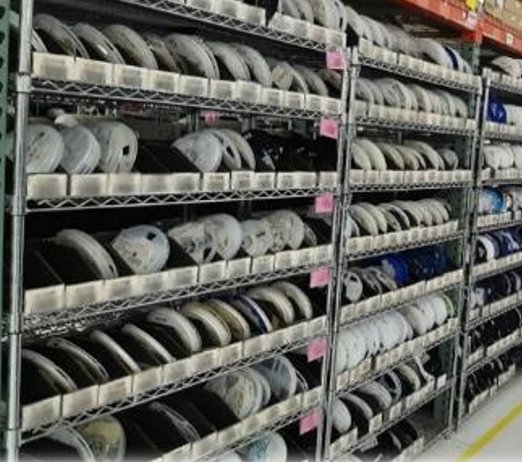The majority of manufacturers we talk to have some sort of space concerns, whether immediate or in the future but most manufacturers don't have a complete grasp on where they are wasting the most space and how they can more efficiently utilize their existing space. In this post we'll look at what causes it and simple utilization solutions, while the next post will focus on the true long-term costs of wasting storage space.
First, where does wasted space come from?
If you're familiar with standard rack-and-bin storage, you'll understand that a huge amount of wasted space comes from statically assigning storage spaces to particular parts. Assuming you have rack-and-bin storage, go through your stockroom right now and find all the bins that are completely empty, nearly empty, half-full, etc. Any bin that is not at 100% capacity has at least some wasted space - a volume that is open and waiting for just the right part to be received and put away.
 Anywhere you see air is wasted space in a rack-and-bin setup
Anywhere you see air is wasted space in a rack-and-bin setup
This type of storage is easy to set up manually and easy for humans to understand and navigate. But, statically allocating these storage spaces trades efficient space utilization for this ease of human use.
Another issue with this type of storage is that it almost always uses generic racks and bins that can be used to store just about anything, rather than purpose-built storage for SMT parts. The size of the bins, the size of the racks, the spacing of the shelves - none of it is optimized for SMT reels, trays, tubes, or really anything. These racks and bins are designed to be a one-size fits all solution that will get the job done with little up-front cost.
That's not to say that there isn't any place for rack-and-bin storage. The flexibility and basic ease-of-use make it a good option for uncommon parts, or for more generic packages like sealed boxes.
Simple solutions will set your storage free
The opposite of static allocation of storage location is dynamic allocation. This means that you don't hold any particular location open for just the right part, and that any package of any part number is free to be stored in any location at any time. Even better is reducing your bin size to accommodate exactly one package so that every occupied storage location is at 100% capacity.
This sounds scary to a lot of manufacturers at first - how on earth will you find the right parts if they are randomly stored throughout your stockroom? This is where software comes in.
The reason we like to statically allocate storage locations is because it's easy for us to remember where things are stored. But, in this age of manufacturing you should be relying on human memory as little as possible. There are endless software-only solutions that will allow you to easily scan parts in and out of randomly assigned locations, and provide the exact locations through a pick list or digital interface of some sort.
That being said, the absolute best path is to choose a storage solution that is purpose built for your exact storage needs, and this is where Smart Storage comes into play. Check out our prior post on Smart Storage for more detail, but SMT manufacturers should be looking for a storage system that is designed for SMT parts rather than something that works at a grocery store or in your pantry too.
Best-in-class Smart Storage Systems will dynamically allocate storage locations that are specially designed for SMT reels, tubes, trays, and whatever other types of packages you store. They come with software features that make picking and putting away fast and easy, and they also integrate to your systems to eliminate data entry, eliminate human errors, and expedite your entire material handling process.
Get in touch to learn more about how Inovaxe can help with all your material handling needs!